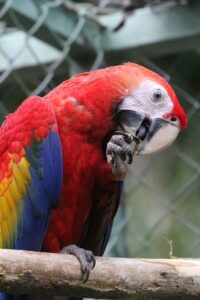

This is part one of two, taking a look at some of the science and try to answer some questions about releasing Macaws. I am going to use Scarlet Macaws and our Punta Islita release site as the example for all of this, as it is where we will be releasing our next cohort of screaming sunshines. The first release at Punta Islita happened in 2011, since then over fifty raucous rainbows have been released here. Importantly some of these birds have started breeding, with the first successful breeding documented in 2015. Release and reintroduction are sometimes used interchangeably, so I thought it might be useful to get into what we mean when we talk about reintroduction. Then importantly, is there a conservation value to it?

To answer these questions, first we need to know what a reintroduction is and then look at our situation in Punta Islita. Come with me as we take a deeper look at a bit of the science behind the work we do.
First, a formal and very general definition. The IUCN, the International Union for the Conservation of Nature, defines a reintroduction as “the intentional movement of an organism into a part of its native range from which it has disappeared or become extirpated in historic times” (IUCN/SSC, 2016). Translated this means, “releasing a species somewhere where it was found, but no longer is found”. So, for our release of scarlet macaws to be a reintroduction we need to know if there were ever any scarlet Macaws living in the Nicoya Peninsula, the region surrounding Punta Islita. For many species, historical range maps are non-existent or unreliable. This is the case for the Scarlet Macaw. Although we can make an educated guess using our current knowledge of the species biology, this would still be a guess. For recent local extinctions, otherwise known as extirpations, local community elders are a great source of information. If you’ve ever seen a Scarlet Macaw, you’ll probably agree they are not a bird you can easily miss, their vibrant colors demand attention. If you’ve ever heard a Scarlet Macaw calling, I’m 100% sure you’ll agree that your ears will not forget the assault they received. They aren’t a bird you can ignore or forget. So, we asked the elders in the communities surrounding Punta Islita if they remember seeing Scarlet Macaws flying free when they were young, solid evidence that Scarlet Macaws are native to the area around Punta Islita. Their stories also suggest they died out around fifty years ago, which coincides with widespread deforestation in the region, with a low of 21% of forest cover remaining in the Nicoya Peninsula in the 1980s (Calvo-Alvarado et al., 2009). With this information, plus our knowledge that there were no Scarlet Macaws flying around Punta Islita before 2011, we can safely say the project at Punta Islita is a reintroduction project.
Great, but then we asked a potentially controversial question, is there any conservation value to a reintroduction at Punta Islita? There are those who argue that Scarlet Macaw releases are not needed in Costa Rica (Monge et al., 2016). As you are reading the blog from an organization releasing Scarlet Macaws, you can probably guess where we sit on this issue. But I think it’s worth being explicit here; we believe reintroductions are a useful conservation tool, like any tool there is a place and a time where they are most effective. Effectiveness is key to ensure we have the biggest impact for the parrots with the resources we have. But how do we know when reintroductions can be effective? I hear you ask. Don’t worry, we’re getting there.

We know from the monitoring of the Scarlet Macaw population in the Central Pacific region of Costa Rica and the north-east of the country that if poaching levels are low, Scarlet Macaws will naturally re-colonize. There are a couple of other prerequisites, firstly it does rely on there being a healthy population nearby for them to expand out of. Secondly, and maybe obviously, there must be habitat for them to move into. Thankfully, forest cover all over Costa Rica has recovered from a historic low in the 1980’s (Sader and Joyce, 1988; Calvo-Alvarado et al., 2009) and there is now quite a bit of un-occupied habitat for them to move into. Unfortunately, in the north-west of Costa Rica natural recolonization is unlikely as there are not any healthy source populations of Scarlet Macaws. This is where reintroductions become a useful tool. If we didn’t use reintroductions maybe one day, in the distant future, the Central Pacific population would naturally expand and recolonize this region. But to speed up this process and help restore a fully functioning ecosystem in this region we can use reintroductions.
So, after a quick run through on reintroductions and if they are useful, I hope you can see how and why we believe reintroductions can be a valuable conservation tool. For Scarlet Macaws in the Nicoya Peninsula, it offers the chance to help re-establish populations that were wiped out over half a century ago. We are doing this by allowing those beautiful, noisy Scarlet Macaw individuals who cannot be released back into the wild, to contribute to the survival of their species through the reintroduction of their healthy offspring. This is what we are doing. This is what, along with partners and collaborators, we will continue to do. Until the day that Scarlet Macaws are a common sight in the skies over the Nicoya Peninsula once again. Be sure to read Part 2 to learn more.
Find out how you can be part of our upcoming release here!

Tom Lewis
PhD Student & Board Member
Calvo-Alvarado, J. et al. (2009) ‘Deforestation and forest restoration in Guanacaste, Costa Rica: Putting conservation policies in context’, Forest Ecology and Management, 258(6), pp. 931–940. doi:10.1016/j.foreco.2008.10.035.
IUCN/SSC (2016) Guidelines for reintroductions and other conservation translocations. Version 1.0. Gland, Switzerland: IUCN Species Survival Commisson. Available at: https://www.iucn.org/content/guidelines-reintroductions-and-other-conservation-translocations (Accessed: 24 September 2019).
Monge, O. et al. (2016) ‘Genetic patterns and conservation of the Scarlet Macaw (Ara macao) in Costa Rica’, Conservation Genetics, 17(3), pp. 745–750. doi:10.1007/s10592-015-0804-3.
Sader, S.A. and Joyce, A.T. (1988) ‘Deforestation Rates and Trends in Costa Rica, 1940 to 1983’, Biotropica, 20(1), pp. 11–19. doi:10.2307/2388421.